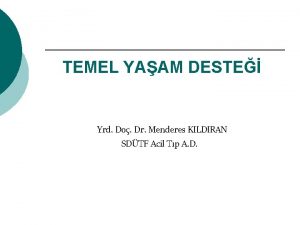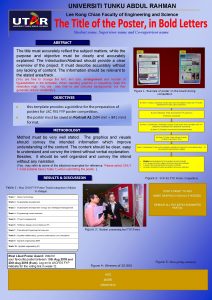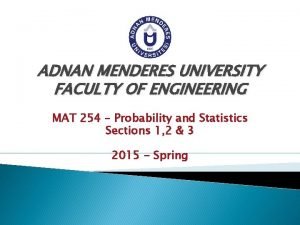ADNAN MENDERES UNIVERSITY Faculty of Engineering Measures of























- Slides: 23

ADNAN MENDERES UNIVERSITY Faculty of Engineering Measures of central tendency and variability MAT 254 Probability & Statistics Week #3 Olcay ÜZENGİ AKTÜRK, Assoc. Prof. Dr.

Data Types • Primary • Ours • Secondary • Not ours • Qualitative data (words) • Blue, short • Quantitative data (numbers) • 1, 2. 5, 10000 • Discrete (countable) • 1 car, 206 students • Continuous (measurable) • 165 cm, 52. 5 kg 2

Sampling Techniques • Probability Sampling (every member of the population has equal chance) • • • Simple Random Sampling (Lottery) Systematic Sampling (every 4 th sample) Stratified Sampling (from each area) Cluster or Area Sampling (form clusters) Multi-stage Sampling (multi-stage) • Non-probability Sampling (samples are selected based on an inclusion rule) 3

Age Frequency 12 2 13 13 14 27 15 4 Presentation of Data Textual Method Tabular Method • Rearrangement from lowest to highest • Stem-and-leaf plot • Frequency distribution table (FDT) • Relative FDT • Cumulative FDT • Contingency Table Stem Leaves 1 7, 8 2 0, 3, 3, 4, 5, 6, 7, 8, 9 3 4, 4, 5, 5, 7, 8, 8, 9, 9, 9 4 2, 3, 4, 4, 5, 6, 6, 8, 9 5 0, 0, 0 Graphical Method • Bar Chart • Histogram • Frequency Polygon • Pie Chart • Less than, greater than Ogive 4

Other Graphical Methods Box Plot (Box and Whisker) Lowest value Highest value Median Upper Quartile Lower Quartile Inter-Quartile Range Scatter Plot 5

How can you represent a huge amount of data (numbers) by using only one (or two) number(s)? q. Minimum of them? q. Maximum of them? q. Average of them? q? ? “CENTRAL TENDENCY” 6

• In statistics, a measure of CENTRAL TENDENCY is a single value that attempts to describe a set of data by identifying the central position within that set of data. As such, measures of central tendency are sometimes called measures of central location. • The most commonly used statistics for measuring the center of a set of data, arranged in order of magnitude, are the mean, median, and mode. q Mean (average) q Median (middle) q Mode (most) 7

Sample Mean ü The mean (arithmetic mean or average) of a set of data is found by adding up all the items and then dividing by the sum of the number of items. ü The mean of a sample is denoted by (read “x bar”). 2 3 7 7 = 2+3+7+7/4 = 4. 75 8

Sample Mean Staff 1 2 3 4 5 6 7 8 9 10 Salary 1$ 1$ 2$ 2$ 100$ 9

Trimmed Mean A trimmed mean is computed by “trimming away” a certain percent of both the largest and the smallest set of values. For example, the 10% trimmed mean is found by eliminating the largest 10% and smallest 10% and computing the average of the remaining values. 10

Sample Median 2 3 7 7 = 3+7/2 =5 3 7 2 2 3 7 7 3 =3 11

Sample Mode The most repeated value in observations 2 3 7 7 7 unimodal 2 2 3 7 7 2 7 bimodal 12

Sample #1 : 1 51 101 151 201 No mode ! Sample #2 : 99 100 101 102 103 No mode ! Measures of spread or variability ? ? 13

Sample Range The difference between the lowest and the highest value of that sample. 2 3 7 7 The range is 7 -2 = 5 14

Variance & Standard Deviation 15

Variance & Standard Deviation 1 3 5 11 = 1+3+5+11/4 =5 16

Population vs. Sample Commonly used Symbols for a Sample and for a Population. 17

Example from textbook 18

Example from textbook 19

Example from textbook 20

Example from textbook 21

Example from textbook 22

END of LECTURE #3 MAT 254 -02 Probability & Statistics 23
 Ege sahil haritası
Ege sahil haritası Menderes kıldıran
Menderes kıldıran Menderes sargın
Menderes sargın Faculty of engineering university of porto
Faculty of engineering university of porto Ulfg2
Ulfg2 Clemson ece lab manual
Clemson ece lab manual Faculty of mechanical engineering thammasat university
Faculty of mechanical engineering thammasat university Anova repeated measures
Anova repeated measures Lee kong chian faculty of engineering and science
Lee kong chian faculty of engineering and science Faculty of civil engineering ctu prague
Faculty of civil engineering ctu prague Faculty of engineering shoubra
Faculty of engineering shoubra Usf canvas
Usf canvas Civil engineering faculty
Civil engineering faculty St.anns college chirala materials
St.anns college chirala materials Igor dujlovic
Igor dujlovic Hijjawi faculty for engineering technology
Hijjawi faculty for engineering technology Lee kong chian faculty of engineering and science
Lee kong chian faculty of engineering and science Faculty of engineering orientation
Faculty of engineering orientation Efe spletna ucilnica
Efe spletna ucilnica Herszon kherson maritime college of merchant marine fleet
Herszon kherson maritime college of merchant marine fleet Bridgeport engineering department
Bridgeport engineering department University of bridgeport engineering
University of bridgeport engineering Hubert kairuki memorial university faculty of medicine
Hubert kairuki memorial university faculty of medicine Solid thyroid nodule
Solid thyroid nodule













































